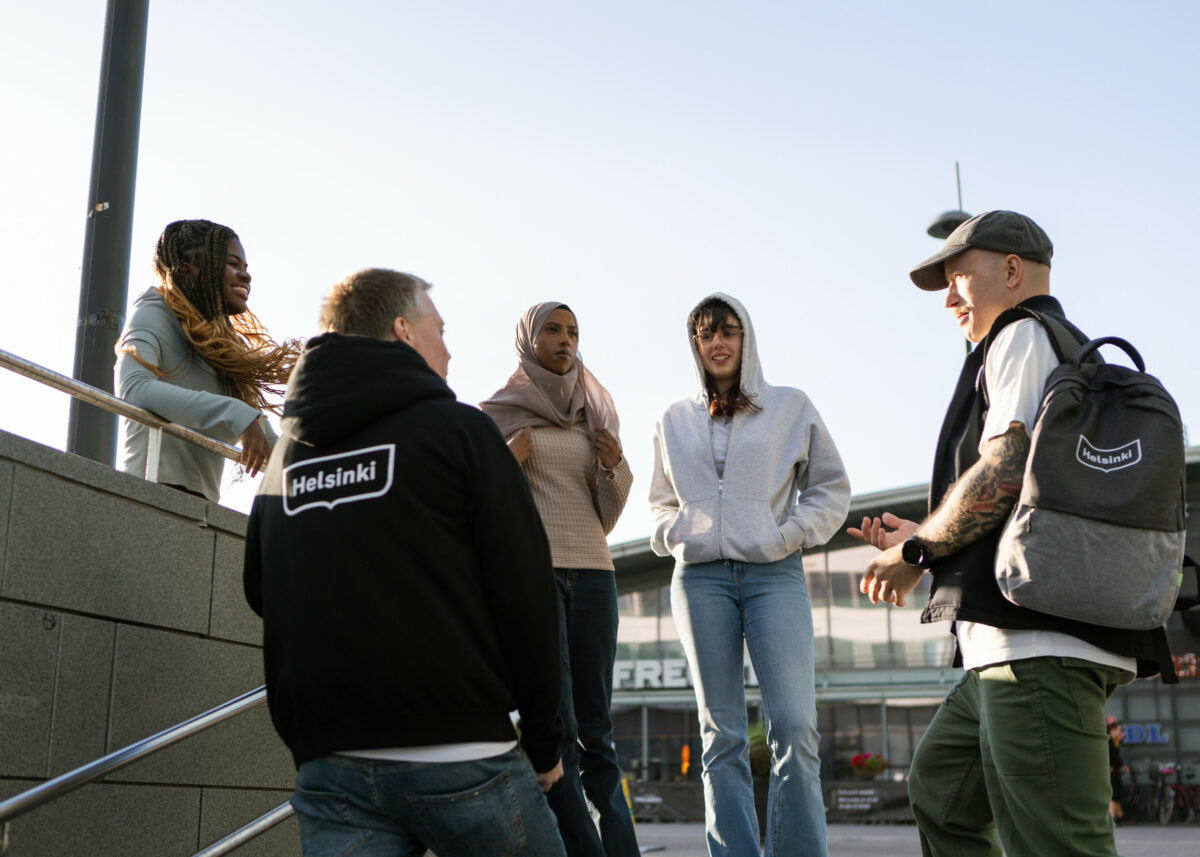
Can youth workers engage in environmental education?
The short answer is: Yes, they can! Environmental and/or sustainability education is about everyday choices. It involves consumption, food, mobility, exchanging ideas, and active participation. A youth worker is often someone who supports young people in their daily lives, helps them navigate life’s challenges, and guides them toward making positive choices.
Those who work with young people play a significant role in society.
Environmental educator, not just a tree-hugger
We are living in the year 2025, in the era of ecological crisis. Polarization is sparking public debate. Polarization is a phenomenon where opinions become sharply divided. Why is political polarization harmful in many different ways? Difficult political issues—such as those related to climate—have become matters of identity, making it harder to reach compromises and mutual understanding. This also challenges us as educators to grow and to process our own emotions.
Our planet is not an inexhaustible source of raw materials. Each of us should adapt our actions to fit within the planet’s ecological limits. The concept of sustainable development is fundamentally tied to the idea of planetary boundaries. Did you know that each year, 12 members are selected for the Youth Agenda 2030 group? The members are aged between 15 and 28, and they work both at the grassroots level and by advising decision-makers on issues related to sustainable development.
Progressive companies and organizations recognize that a responsible working environment is a vital part of their sustainability strategy. They work with experts and utilize various environmental management systems to ensure this. The City of Helsinki is aiming to do the same. There’s still a long way to go, but one great example of success is the closure of the Salmisaari coal power plant more than five years ahead of schedule. The era of coal in Helsinki’s energy production officially ended on April 1st, 2025 (Yle news).

You can be the person who nurtures children’s and young people’s environmental sensitivity and emotions
It is often assumed that environmental education is the responsibility of early childhood education or schools, overlooking the influence that youth activities can have. Another common narrative is that environmental education is the job of organizations, which indeed have their own specific role to play. However, meaningful discussions take place in youth activities on a weekly basis, and these conversations can have a significant impact on a young person’s life. For this reason alone, the fundamentals of environmental, climate, and sustainability education should interest each and every one of us.
Environmental sensitivity refers to an emotional and empathetic relationship with the environment, built upon an individual’s experiences and perceptions, as well as the ability to observe and sense the environment and the changes occurring within it. An environmental educator is ultimately just someone who nurtures, encourages, teaches, and supports participants, while also bringing forward various perspectives that might otherwise be overlooked.
The role of education cannot be to spread fear, but rather to create an atmosphere of hope – and the role of environmental education is especially to do that.
Essi Aarnio-Linnavuori, Lead Expert in Environmental Education (WWF)
Since the most significant pillars of our relationship with nature are formed in childhood, it’s important for youth workers to be aware that not everyone may have developed this relationship. Especially among immigrant-background youth, there may be prejudices and fears related to nature. In such cases, it’s a good idea to approach the activity and the topic with a lower threshold. Ask yourself: what kind of relationship with nature do you have?
It’s also wise to avoid unnecessary jargon and elaborate metaphors. As a guide, it’s important to know why something is being done and what the objective of the activity is, but for the participants, what matters more is that together they have succeeded in doing something meaningful. Meaningfulness and participation are linked to psychological basic needs, namely autonomy, competence, and relatedness (Aivoliitto). Participation should be a guiding principle that permeates all municipal services. The same applies to acting in a sustainable way.
Nature works its magic for the guide
“What about those who aren’t interested in these things?” It’s just as important to provide information to those who may not find environmental issues engaging. The wellbeing benefits of nature can be enjoyed, even if someone isn’t personally interested in environmental topics. And why should something that’s not fully understood spark interest? It’s crucial to offer different perspectives and opportunities for participation, even for those who don’t care about “environmental matters.” These discussions are at the heart of youth work.
The natural environment can provide even the more reserved and shy young people with a calming space to connect. In nature, there’s no need to be constantly too close or face-to-face. It’s easier to just be yourself. Revitalizing nature experiences can become a safe mental refuge for a young person—a place they can return to in their mind for comfort. Even the most anxious minds find peace when in nature. Nature opens up quietly through sensitivity. Through the experiences and sensory encounters that nature offers, we aim to open a connection to one’s own feelings and simultaneously awaken an interest in the natural world. Revitalizing experiences in nature increase hopefulness and vitality, thereby laying a foundation for social growth as well.
In nature, one can experience a profound sense of belonging to something larger—a shared whole, in which one has their own meaningful role. Many studies have shown that spending time in nature enhances both physical and mental wellbeing. Just five minutes of green exposure a day can lift your mood. Research also indicates that spending time in nature lowers blood pressure and reduces stress. It’s been found that 20 minutes in nature reduces aggression, sadness, and anxiety, while increasing energy levels. Longer exposure to greenery improves focus as well. Nature allows us to escape the hustle and bustle of everyday life. The power of nature experiences lies in the fact that they don’t have to be “achieved.” Simply being is enough.
The Natural Resources Institute Finland and the Finnish Institute for Health and Welfare are exploring the health benefits of nature and their economic significance | Natural Resources Institute Finland (March 28, 2024).

One doesn’t always have to reinvent the wheel
It is often assumed that in order to act responsibly, one must first give something up or at least bargain. The development of the work environment and practices should be viewed as an ongoing model, rather than as individual projects. When the work environment and tools are developed based on a lifecycle model, it is possible to consider responsibility at every stage of development, from planning to implementation. Sometimes, it’s enough to assess already established effective practices and think about whether the established norms could be renewed to be more sustainable.
The everyday work of youth workers is not in conflict with environmental, sustainability, or climate education—in fact, quite the opposite. Youth is a time for developing skills and abilities. It’s important that young people in Helsinki have equal opportunities to grow and develop in diverse ways. During youth, we learn to take responsibility and make choices: we grow, experiment, make mistakes, and learn. (NUPS). The “Climate Thoughts – A Guide to Climate Education in Youth Work” by the Youth Academy provides youth workers with additional tools to address young people’s climate emotions, as well as engage in discussions and activities related to climate issues.
Each of us can be someone who promotes a responsible work culture through our own example and actions, a culture that extends not only to our own work community but also to the way we engage with young people. To promote these matters, you don’t need to be a trained environmental educator or know everything there is to know about nature. The “Climate Thoughts” guide is a good starting point. After familiarizing themselves with it, youth workers will be better equipped to encourage and support young people in participating in climate discussions, activities, and advocacy on a day-to-day level.
Accept that everything can’t be influenced
This, too, is something that should be accepted, and it’s better to focus energy on areas where we have the ability to influence. You might also consider whether collaborating with an organization or stakeholder could help in implementing a potential idea.
Let’s return to the beginning of the article and the topic of polarization. It’s important to remember that blaming individuals is not the most effective way to advance matters. We all need to be aware that emotions are present in every event in life and in all interactions, including at work. However, with emotional skills and the support of the work community, workplace emotional storms can be turned into strengths.
Ultimately, one of the core tasks of a youth worker is to strengthen young people’s trust in themselves and in the future. Often, small actions have the greatest impact.
This task is not always easy, which is why the contribution of the entire work community is needed!
Text: Annina Wallinsalo (15.4.2025)
Pictures: Helsinki Material Bank
Reading suggestions and tools for youth workers:
Kuinka ihmisten luontoyhteyttä arjessa voitaisiin lisätä? – 3 näkökulmaa
Nuorisotyöntekijä ilmastokasvattaa – 10 vahvistavaa nostoa
Vinkkilista ilmastotoiminnan suunnitteluun
Ilmastokeskustelun lyhyt oppimäärä syyllistäjille ja syyllistyjille
Me vastaan te – Suomi jakaantuu yhä voimakkaammin (Yle, 2024)
Would you like to study to become an environmental educator?
“Great foundational education, new perspectives, now the world is wide open.”
“An abundance of knowledge, skills, and professional growth in just one year.”
“Absolutely amazing trainers. The group was also very supportive and had a great sense of humor.”
The SYKLI Environmental Education Training Program prepares you to take the environmental sector’s specialized vocational examination, which is worth 180 competency points.




